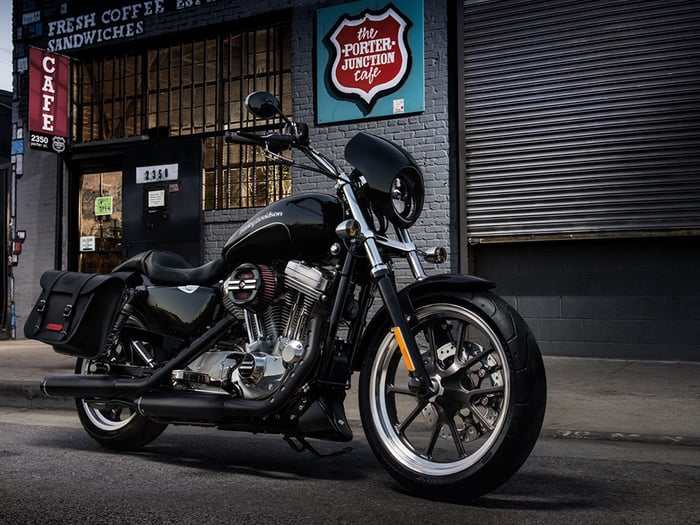Harley-Davidson (HOG -0.29%) is resuming its losing ways. After it managed to sell exactly 33 more motorcycles in the U.S. in the fourth quarter of 2016 than it had the year before, snapping a two-year losing streak in the process, the big bike maker picked up where it left off in the first quarter and reported that sales fell again.
It's not necessarily Harley-Davidson's fault since the entire motorcycle industry is in a slump, but it is still worrisome since it has new, even more grandiose plans for the future.

Image source: Harley-Davidson.
Not revving its engines
The motorcycle king said global sales fell 4.2% for the period, but they were down 5.7% domestically even as they remained "in line with our projections." Harley predicted it would ship between 66,000 and 71,000 bikes this quarter, and they came in at the high end with 70,831 hitting dealer lots. Even so, that's 15% below last year's first-quarter shipments, and it shows how deep of a hole the industry and Harley are in.

Data source: Harley-Davidson quarterly SEC filings. Chart by author.
The key for Harley might be whether it can gain traction again in international sales. While the U.S. is its bread-and-butter market, generating over 60% of total sales, foreign markets have at least shown growth in recent periods, though not in the latest quarter, where sales fell 1.8% from last year. But the second quarter is the biggest quarter both here and abroad, and if it can get the rubber on the pavement again, it might at least help offset what's seen as a protracted contraction in the U.S.
Slacks sales here, there, and everywhere
What surprised Harley was the weakness exhibited by the Asia-Pacific market, its second largest international market, which saw sales tumble 9.3% from last year. That market started slipping late in 2016, when sales fell 0.4% in the fourth quarter, but now it appears the decline is accelerating. No doubt sales have been hurt by a strong U.S. dollar, which makes products more expensive. This is an especially difficult situation for a premium priced luxury good like a Harley, but the bike maker thinks the back half of the year will show improvements.
Here in the U.S., Harley-Davidson wasn't helped by its decision to hold back model year 2017 bikes from dealers so they could sell the leftover stock of 2016 bikes that they still had on hand (accounting for the steep year-over-year drop in shipments). CEO Mike Levatich admits it hurt sales in the first quarter, but now he's happy with where the inventory situation is as well as its market share position, which it says grew in the period.
Yet to help get those bikes moving, one thing Harley did was something previously unheard of: It began discounting its bikes. Well, it ran some special promotions for top-tier buyers giving them special interest rates on purchases, which ended in February. But then dealers began putting together their own special programs like lower interest rates or no money down to move bikes, and Harley began providing the dealers with incentives to help them.

Image source: Harley-Davidson.
Harley-Davidson has always viewed its bikes as premium products that deserve to be premium priced, and that hasn't changed. It viewed the situation in this period as a very unique situation, one which resulted from it having shipped too many bikes because it misjudged how serious the downturn was in the market. The programs, though, are very short-lived and will end at the end of the month.
Still the king of the road
Harley, of course, owns half of the U.S. motorcycle market, and second place Polaris Industries (PII -0.27%) trails far behind in the single digits to low double digits, depending on who's counting. But Polaris' recent decision to retire its Victory brand and put all of its energy into Indian Motorcycle, which has proved extremely popular and still exhibits double-digit growth rates despite the industry slump, could prove challenging to Harley.
Harley-Davidson has an ambitious plan laid out for the next 10 years. Not only does it want to bring in 2 million new Harley riders, but it will also introduce 100 new motorcycles over the coming decade. That may be a bit much considering the state of the industry and of Harley itself.
That's 10 new models every year for 10 straight years. When it introduced eight new bikes in 2014, it was a Herculean effort that was deemed "the largest new model launch in Harley's history." Now it's going above and beyond that by doing so every year for the next decade.
Perhaps that's just what it needs to do. Indian, for example, has unveiled a handful of new models for the current model year: two new Chieftain bikes that represent something of a departure from the traditional styling motorcycle enthusiasts have come to expect from the historic brand, and a new leather-bagged Roadmaster Classic. Harley's styling may be seen as stale, which is contributing to slack sales, and new models that not only build upon but expand those lines could help juice sales.
It's still a risky proposition, and with sales resuming their losing ways, the 100 bikes in ten years program may need to be pushed further out.

